Paris 2015: The Price of Freedom of Expression
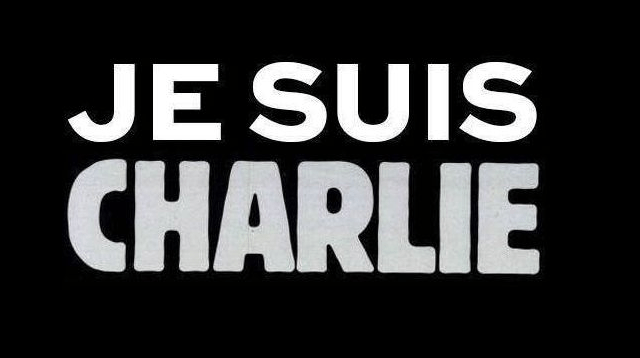
“I am Charlie. You are Charlie. We are all Charlie.” – Journalist Peter Bella
For the latest, see: Paris Unity Rally Largest Demonstration in History
The car drove off as twelve people lay dead inside the offices of the magazine, blood spattered throughout a conference room where they were participating in a morning meeting. Ten of them worked for the magazine including its editor, Stephane (Charb) Charbonnier.
The transgression for which the gunmen were seeking vengeance was not murder (it was not an eye for an eye) nor stealing nor rape – in fact, nothing violent. Nothing illegal. The transgression was engaging in satire involving the Prophet of Islam. Depicting his image in a cartoon, publishing a joke issue.
2014 was a perilous year for journalists with 60 killed in the line of duty. The first journalist to die in 2015 was killed in Yemen just days before the Paris attacks. But this was no mere killing; it was a calculated, well-planned, coordinated massacre, carried out commando style, according to French security authorities.
Rocco Contente, of the Paris branch of the police union Unité, described the scene inside the office as “butchery. It’s carnage inside. They went in there to kill as many people as possible”
THE FALLEN
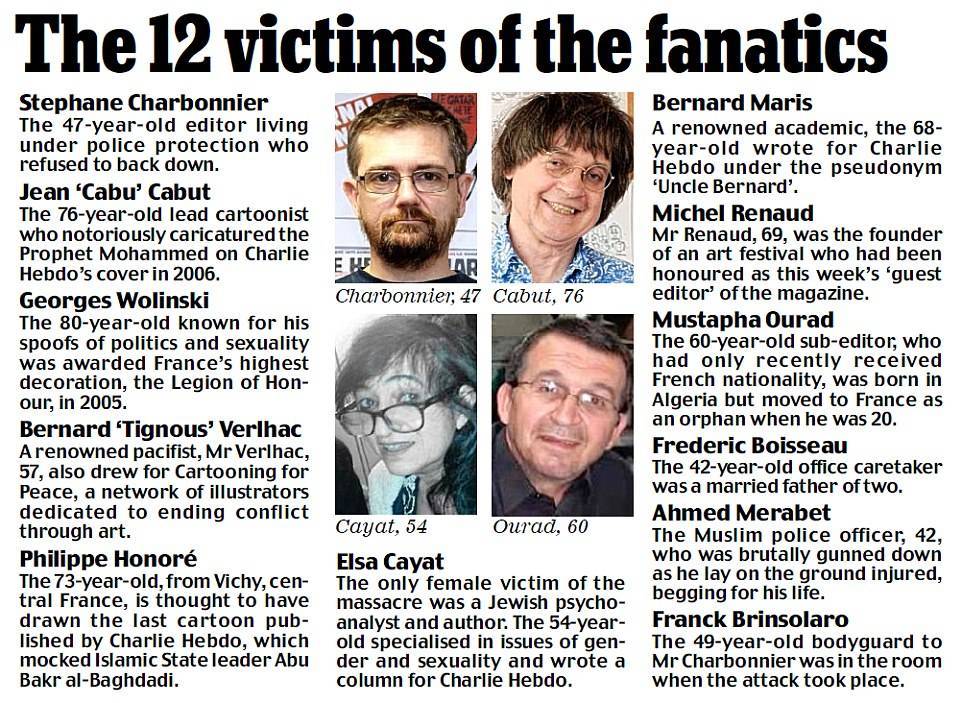
How the attack unfolded
Dressed from head to toe in black, two heavily armed gunmen emerge from their small black Citroen at 11.20am on a chilly and dry Paris day.
One carries a rocket-propelled grenade launcher and both are armed with Kalashnikovs.
A third man is in the car. Having abandoned the vehicle in the middle of the tree-lined street, the pair make their way towards the door of No 6, Rue Nicolas-Appert.
‘Is this Charlie Hebdo?’ they scream at two unassuming maintenance workers. The men tell them the office of the satirical magazine is two doors down and the gunmen move on, but not before shooting dead one of the workers – the first of their 12 victims.
According to tweets from Yves Cresson, who works for the media production company Bayoo next door, the two attackers initially walked into his office. ‘Taking advantage of the postwoman, two armed men wearing balaclavas entered our offices,’ he tweeted. ‘They were looking for Charlie.’
11.25am: Terror of the young mother and her daughter
Florence Pouvil, a sales assistant who worked opposite the Charlie Hebdo offices, said: ‘I saw two people with big guns, like Kalashnikovs, outside our office and then we heard firing. We were very confused. There were two guys who came out of the building and shot everywhere. We hid on the floor, we were terrified.
‘They came from the building opposite with big guns. We feared for our lives so we hid under our desks so they wouldn’t see us. Both men were dressed in black from head to toe and their faces were covered so I didn’t see them.
‘They were wearing military clothes, it wasn’t common clothing, like they were soldiers.’
An estate agent said that before entering the building, the attackers approached another man in the street, saying, ‘Tell the media that this is Al Qaeda in Yemen.’
Arriving at No 10 – the offices of Charlie Hebdo – the two men approach Corinne Rey, a cartoonist who is arriving at work with her young daughter, having just picked her up from kindergarten.
The gunmen force the terrified woman, also known to her friends as ‘Coco’, to punch in the four-digit security code allowing them access to the magazine’s office. Miss Rey was frogmarched upstairs with her daughter. The pair hid underneath a desk during the subsequent chaos.
Miss Rey said: ‘They said they wanted to go up to the offices, so I tapped in the code.
‘They shot on Wolinski, Cabu… it lasted five minutes. I took shelter under a desk. They spoke perfect French. They said they were from Al Qaeda.’
11.35am: It’s like a butcher’s – there are so many dead
Inside the magazine’s modern building, on the second floor, reporters and editors are holding their morning news conference.
One witness, who was in an office across the corridor, said she heard ‘a huge boom’. ‘Then someone opened the door to our office and asked where Charlie Hebdo was. He had a rifle. We backed away,’ she said. Inside the office, the men call out the names of their targets before shooting them dead.
Among those killed were Stephane Charbonnier, 47, the magazine’s editor; his police bodyguard; renowned cartoonists Georges Wolinski, 80, Bernard ‘Tignous’ Verlhac, 57, and Jean Cabut, along with 68-year-old writer Bernard Maris.
Laurent Léger, a Charlie Hebdo writer, managed to sound the alarm and make a phone call at 11.40am. He told a friend: ‘Call the police. It’s carnage, a bloodbath. Everyone is dead.’ Then the line went dead.
A police source said the two ‘calm and determined gunmen’ went directly up to the editorial room and knew their target. ‘It was Charb they were targeting. The two attackers looked for him in the room, shouting, “Where is Charb? Where is Charb?” They killed him then sprayed everyone else.’ Amid the carnage, one journalist texted a friend to say: ‘I’m alive. There is death all around me. The jihadists spared me.’
Others took refuge on the roof, including Benoit Bringer, a journalist whose office is next door. ‘There were very many people in the building,’ he said. ‘We evacuated via the roof just next to the office.’
Witnesses said the pair cried ‘we have avenged the prophet’ and ‘Allahu akbar’ (God is greatest) as they left.
Another said: ‘It’s like a butcher’s inside there now. There are so many dead.’
11.50am: Police arrive on bicycles – then a firefight
The gunmen return to the street – apparently as calmly as they had arrived. From his position on the roof, Mr Bringer said he saw them emerge from the office.
‘Three policemen arrived by pushbike,’ he said, ‘but they left naturally as the attackers were armed.’
The gunmen climb back into their Citroen as more police arrive on the scene and a firefight ensues.
The killers fire at the police car, shooting more than a dozen times. A police spokesman, Rocco Contente, said the men ‘appeared to have opened fire on everyone.
‘It was carnage, absolute butchery.’
As they drive away, the gunmen come across another police car in the street. They get out and spray the car with bullets as its wounded driver desperately reverses back up the street.
The reversing police car crashes into a parked car and the wounded officer staggers from his vehicle.
Distressing video footage shows two of the attackers getting out of the vehicle and opening fire on the officer from about 20 yards away. He falls to the floor, his arms out – apparently pleading for mercy.
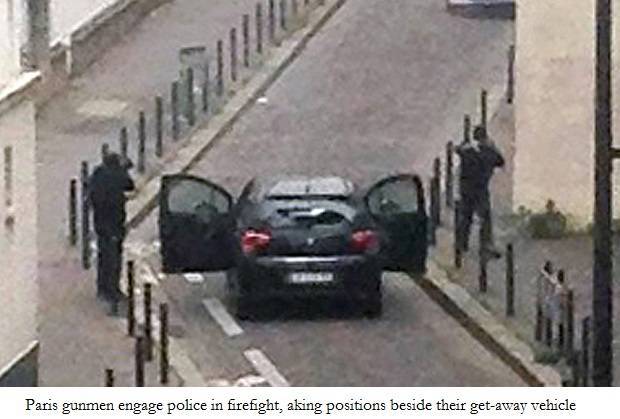
They advance towards him, rifles on their shoulders. One of the gunmen, who is slightly in front of the other, casually breaks into a jog, and shoots the wounded policeman in the head at close range before walking back to the car shouting: ‘We have avenged the Prophet Mohammed, we have killed Charlie Hebdo.’
One of the gunmen bends down to pick up a shoe before getting in the car, which speeds away.
At the magazine’s offices, a man emerges crying. ‘They are all dead,’ he says, desperately pleading with bystanders to call the police. Gérald Kierzec, 40, a casualty doctor on duty at Hôtel Dieu, was among the first on the scene.
‘I could see this was a military-style attack,’ he said. ‘There was a first body lying in the lobby. Then I took the stairs which were covered in blood.
‘When I got to the second floor, there were bodies lying one on top of another.
‘It was carnage with war wounds. There was blood everywhere.
‘These were Kalashnikov injuries with huge bullets that create huge trauma in the victims’ faces and chests. They literally explode. As a civilian doctor who deals with car accidents and the like, I have never seen anything like it in my career, so many wounded by gunfire. This was clearly a terror strike.’
Some survivors are taken to Hotel Dieu. They were visited by President Francois Hollande, who left in a car with blacked-out windows. Other victims were taken to Pitie Salpetriere, the hospital where Princess Diana died in 1997.
Elsewhere on the street, there was terror.
Fradji Guez said his four-month-old granddaughter Joanne was in the nursery near the Charlie Hebdo offices.
‘The staff heard the shooting and were so frightened that they hid the children under the cots,’ he said. ‘They were utterly terrified. It’s horrific.’
Noon: They steal another car – but spare a dog
Offices of French media, including Le Monde, the country’s main newspaper, are put under police protection. The terror alert in France is raised to high.
Driving away at high speed, the Citroen ran down a pedestrian, who is reported to be in a serious condition.
The attackers made it as far as the junction of Rue Sadi-Lecointe and Rue de Meaux, in the 19th Arrondissement, not far from the Place de Stalingrad, before abandoning the damaged car and hijacking another.
A witness said: ‘They pulled a man, around 60, out of the car behind, a grey Renault Clio. The guy said, “Wait, let me have my dog!” They let him get his dog before they drove off. The police arrived five minutes later.’
4.30pm: Possible hideout searched by police
Anti-terrorist police search a possible hideout used by the attackers. The rented flat is situated in the north-east Paris suburb of Pantin. There were no arrests.
5pm: Thousands gather to mourn the victims
As night falls, thousands start gathering in central Paris in protest and solidarity against the killings. Je Suis Charlie – I am Charlie becomes their rallying call, topping hashtags on Twitter that day.
At the Place De La Republique, mourners lit candles spelling the word ‘Charlie’.
One woman said: ‘It’s hard to describe. Wolinski was, well, he was France’s cartoonist. It is like someone has come to kill Dali, Picasso – all in one go. They have killed the satire, the “patrimoine”, the heritage. This is one of Paris’s saddest days.
The Killers
Many immediately thought the attack was due to the call of ISIS to carry out lone-wolf attacks in France and other countries. In fact, the magazine’s last tweet had satirized this call. Surely these were foreign terrorists? As it turned out, the alleged killers, the Kouachi brothers (Cherif and Said), are both French citizens, born in that county. ‘They spoke perfect French,’ said Corrinne Rey, a cartoonist at the magazine who was compelled under threat to let them in the offices. ‘…they said they were from al-Qaeda.’
The following was extracted from CNN:
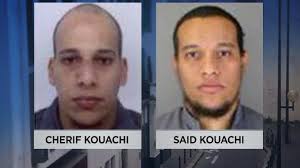
CHERIF KOUACHI
The younger of the two brothers has spent time in jail for links to terrorism. He was sentenced to three years in prison in 2008 for being part of a jihadist recruitment ring in Paris that sent fighters to join the conflict in Iraq.
He was arrested in January 2005, at age 22, when he and another man were about to set off for Syria en route to Iraq, where war was raging.
Kouachi’s lawyer Vincent Ollivier said at the time that his client’s profile was more “pot-smoker from the projects than an Islamist.”
“He smokes, drinks, doesn’t sport a beard and has a girlfriend before marriage,” Ollivier told the French newspaper Liberation the month after his client’s arrest.
A report from the TV network France 3, which apparently first aired in 2005, described Kouachi as a young fan of rap more interested in chasing girls than going to the mosque. But he changed when he became a student of Farid Benyettou, according to the report.
At trial, Kouachi was described as coming under the influence of Benyettou, a radical Muslim preacher, at the Addawa mosque in Paris’ 19th arrondissement.
Kouachi’s cursory training for his planned mission in Iraq involved jogging in Paris’ hilly Buttes-Chaumont park and being shown the basics of operating a Kalashnikov by a man he met at the mosque, French newspaper Le Monde reported at the time.
Kouachi told the court that he was motivated by U.S. troops’ abuse of detainees at Abu Ghraib prison in Iraq. But he said he was relieved when he was arrested.
“The closer the departure got, the more I wanted to turn back,” he told the judge, according to Le Monde. “But if I chickened out, I was in danger of looking like a coward.”
The court said Kouachi had wanted to attack Jewish targets in France but was told by Benyettou that France, unlike Iraq, wasn’t “a land of jihad,” Bloomberg News reported at the time.
Prosecutors presented no evidence to the court of any plans to carry out attacks in France, according to a New York Times report.
Kouachi and six other people, including Benyettou, were convicted and sentenced to prison in 2008 for their roles in the recruitment ring.
Kouachi didn’t actually go to prison after the trial because half his three-year sentence was suspended and he had already spent enough time in pretrial detention, Bloomberg reported. He was released from custody before the trial.
A former pizza delivery boy, Kouachi was working as a fishmonger in a supermarket at the time of the trial, according to French media.
He told the court that his main interest at the time was rap music, according to Bloomberg.
In 2010, Kouachi was charged in connection with a foiled plot to aid the escape of Smain Ait Ali Belkacem, an Algerian Islamist imprisoned for bombing a Paris commuter rail station in 1995. But public prosecutors later dropped the charges, according to Le Monde.
Kouachi was born in Paris to Algerian parents who died when he and his brother were young, Liberation reported.
He was raised in a home in Rennes, a city in the northwestern French region of Brittany, according to the newspaper. He obtained a qualification in sports education before moving back to Paris, it said.
French newspaper Le Figaro talked to neighbors near the apartment in the northern Paris suburb of Gennevilliers that Kouachi reportedly shares with his wife.
People in the neighborhood described him as polite and reserved, the newspaper reported. The local baker, whose name was given only as Salah, said the younger brother was “always cheerful.”
Inside the building, a man who lived on the same floor as Kouachi and his wife described her as wearing a full veil through which only her eyes were visible. The wife “doesn’t speak to any man, ever,” the neighbor, who was only identified by his first name of Eric, told Le Figaro.
SAID KOUACHI
The elder Kouachi brother, is a shadowy figure about which little is known.
A U.S. official says the United States was given information from the French intelligence agency that Said Kouachi traveled to Yemen as late as 2011 on behalf of the al Qaeda affiliate there.
Once in Yemen, the older brother received a variety of weapons training from al Qaeda in the Arabian Peninsula (AQAP) — the affiliate in Yemen — the official said, including on how to fire weapons.
It is also possible Said Kouachi was trained in bomb making, a common jihadist training in Yemen.
A French official told CNN that Said Kouachi received training in Yemen. The official did not give details about when the trip occurred or how long it lasted.
He has never been convicted of a crime and resided in Reims, northern France, French Interior Minister Bernard Cazeneuve told reporters in Paris on Thursday.
His identification card was found in the vehicle abandoned after Wednesday’s attack, Cazeneuve said.
“It was their only mistake,” Dominique Rizet, BFMTV’s police and justice consultant, said earlier.
Mohammed Benali, who runs the mosque in Gennevilliers, the suburb where Cherif Kouachi’s apartment is, said the two brothers used to come to Friday prayers there “not assiduously but regularly.”
He told Le Figaro that he knew Said Kouachi better, but that he hadn’t seen either of the brothers at the mosque in at least two years.
Benali said the older brother was “a very reserved man,” but he recalled one angry outburst in the mosque when the imam encouraged the faithful to vote in the presidential election.
Said Kouachi “had an angry reaction, he left the prayer room and voiced his disagreement,” Benali said. “For these lunatics, when we practice and teach moderate Islam — actual Islam — we’re nonbelievers.”
BFMTV reported that like his brother, Said Kouachi was born in Paris and was known to police.
The Liberation report suggested that at the time of Cherif Kouachi’s arrest in 2005, the brothers were staying in Paris with a Frenchman who had converted to Islam.
Said Kouachi was taken into custody and questioned during that investigation but was later released, Le Figaro reported.
His name also came to the attention of police during the investigation of the 2010 prison break plot, but there wasn’t enough evidence to keep investigating him, Le Monde reported
Post-cold war, extremist Islam has been the greatest threat to freedom of expression, claiming the lives of many. Most recently the beheadings of a series of journalists by Isis demonstrated the danger of reporting from conflict zones and areas where without effective rule of law. But nobody expected that a magazine, which publishes cartoons lampooning rather equally, various religions, would be targeted on their home turf.
The Reaction: Je Suis Charlie
Thousands gathered in candle-light vigils and rallies in defence of freedom of expression as darkness fell on January 7th.
They carried placards, saying ‘Je suis Charlie’ – I am Charlie, succinctly declaring their solidarity with the fallen. They meant that an attack on freedom of expression is an attack on them – that freedom of expression is as much an article of faith in a free society as any religious symbol.
The slogan was first used on Twitter and spread to the Internet at large. The website of Charlie Hebdo went offline shortly after the shooting, and when it returned it bore the legend Je Suis Charlie on a black background.
The hashtag for the slogan trended at the top of all twitter hashtags on January 7th.
Many felt, Journalist Peter Bella put it best when he wrote that more than 100 reporters were killed “doing their jobs” in 2014 and that “many were executed just because they were journalists.”; adding, the hashtag “was created to support Charlie Hebdo, the victims, and freedom of the press, speech, and expression. I am Charlie. You are Charlie. We are all Charlie.”
Related
French Soldiers Flood the Streets of Paris
‘I couldn’t save them’ – a columnist at Charlie Hebdo describes the horror
Stephane Charbonnier, Charlie Hebdo editor: ‘I prefer to die standing than living on my knees’
AJC Criticizes Self-Censorship of Charlie Hebdo Cartoons
Charlie Hebdo plans to publish 1 million copies of new issue next week
 The Global Calcuttan Magazine
The Global Calcuttan Magazine 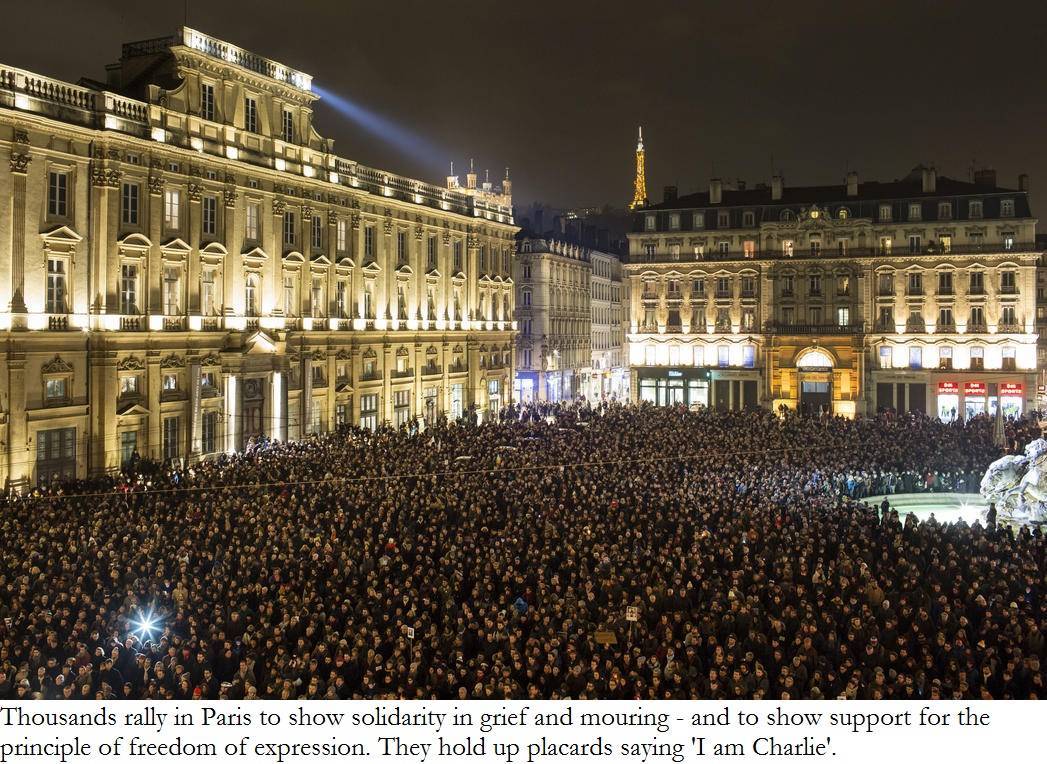
This is a tragedy. I don’t understand why non-Muslims should punished for blasphemy? It’s like world domination. fanatics dictating what people can laugh at. it must be resisted first by the media. when media outlets say, ‘I believe in Freedom of Speech BUT…’ then everything in front of the BUT is a lie!
Yes. There is this Muslim BSP politician in India, who offered 5.1 Million Rupees or around $100,000 US dollars as a reward to the killers for ‘defending the prophet.’ That guy should be put in jail for inciting violence as per India’s laws on upsetting social order due to religion – where is the court case against him?
Any free society should condemn this act. And, BTW, it’s not that all Muslims are like the killers. A Muslim cop died trying to protect Charlie Hebdo’s right to ridicule all religions including his. A Hezbollah leader has recently spoke out to condemn the attack.